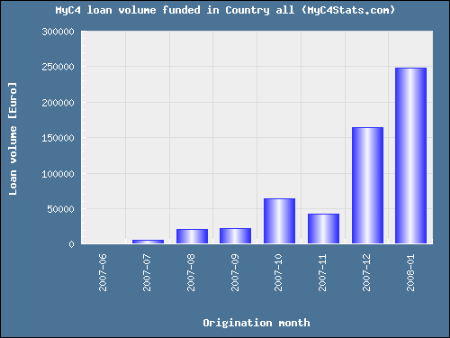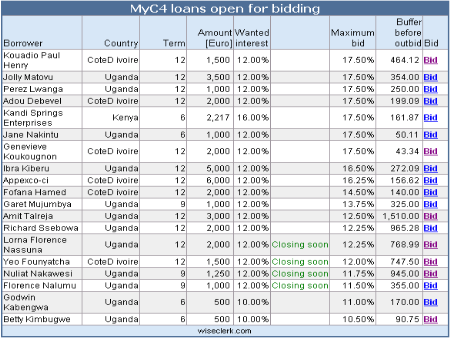2007 was a year of launch and growth for most players. What trends in peer to peer lending can be expected in 2008?
More competition and entering more national markets (probability 100%)
In many markets multiple p2p lending services will compete for the attention of lenders and borrowers, especially in the largest market: In the United States Globefunder.com and Loanio.com will launch. In other markets, where there is no national p2p lending service established yet (e.g. Canada, New Zealand, Spain), p2p lending will be introduced by the launch of a service.
Insurance against defaults (probability 75%)
Not totally new, since Boober.nl and Smava.de already offer some protection of the loan principal. Insurance can be implemented as a classical insurance product (supplied by an insurance company) or as a market mechanism, spreading the risk over multiple loans.
Secondary market (probability 25%)
One of the disadvantages for lenders currently is that on all p2p lending platforms, the invested money i locked in for the duration of the loan term. Prosper.com has allready announced that it plans a secondary market, enabling lenders to sell and buy loans any time. Depending on the market there are huge regulatory hurdles to allow trading of loans. For example German executives told P2P-Banking.com that on the German market a secondary market is unlikely for years to come.
Cross-market lending (probability <25%)
Aside form the social lending approaches (Kiva, MyC4, Microplace) so far all service are open only for lenders and borrowers that live in the same market. If lenders could lend to borrowers in markets with higher key interest rate than the market the lender lives in, the advantages could outweight the risks. In the European Union due to the Euro zone there would be no currency exchange risk. Again there are steep regulatory hurdles to be taken.
Variable interest loans (probability ?)
So far all loans are for fixed terms (prepayment allowed) with fixed interest rates. Variable interest loans could add flexibility. The interest rate could rise or decline following an indicator (e.g. market prime rate). Another possibility would be a mechanism where the variable interest rate would rise or fall as a result of the level of defaults of the credit grade. This could protect lenders, if the actual default ratio is higher then the forecasted default ratio.
Third party bidding management (probability?)
Just a thought. Lenders could allow a third party to manage their portfolio. Like an investment funds the lender would invest an amount of money, while the funds manager does the actual selection of loans. This could possibly be done by a sophisticated software (would you trust this?) selecting loans by statistical analysis of performance of loans with similiar parameters or by a fonds manager. The later is unlikely because the amount of time needed for each loan is too high to be covered by fees.
I'll check at the end of 2008 to see how these trends developed.
 Kiva.org, which allows everybody to help funding microloans to entrepreneurs in developing countries, will achieve the milestone of 25 million US$ loan volumn within the next two days.
Kiva.org, which allows everybody to help funding microloans to entrepreneurs in developing countries, will achieve the milestone of 25 million US$ loan volumn within the next two days.


